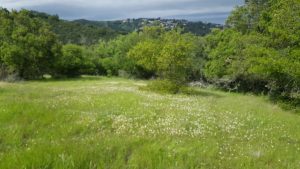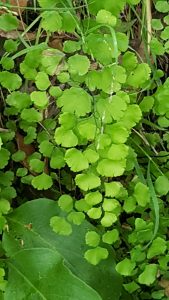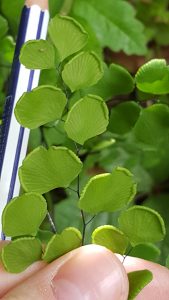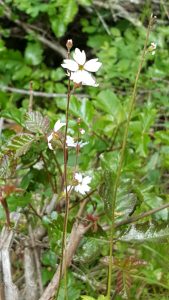Edgewood County Park: 37.47367, -122.27864
Edgewood County Park is a lovely area in San Mateo County. It is known for its wildflowers in the spring and 160 acres of serpentine soil. It has many native plant species, and these include rare and locally endemic species. This area is also notable because it includes grasslands, chaparral, coastal scrub, foothill woodlands, and wetlands. In addition, it includes parts of Cordilleras Creek and Laguna Creek. I would classify the area we visited as a Foothill Woodland because it included medium sized trees such as coast live oak and toyon. The trees here were 20 meters tall or shorter, and many areas were relatively moist and shaded.
Adiantum jordanii (California maidenhair)
A. jordanii is a fern species that is native to California and Oregon. A member of Pteridaceae, it can be recognized by its 2-3 pinnate and asymmetrical leaves. It is bright green and has blackish stems. In addition, one can see false indusia on the underside of this fern species. The sori and false indusia tend to be less than 5 millimeters in size. This fern is one of two maidenhair species in this area. This particular specimen was found on the side of a moist hill in complete shade.
Lithophragma affine (common woodland star)
L. affine is a perennial herb in the Saxifragaceae family. It is also native to California. It usually grows to be 10 to 60 centimeters tall. Its leaves are lobes and often have sharp-tipped teeth. This species has pedicel inflorescence and with bright white flowers. These flowers are in parts of 5 and have ovate/elliptic petals approximately 5 to 13 millimeters long. One can also see their reddish-green sepals. Most noticeably, the petals are 3-lobed at their tips. This particular specimen was found on a hillside in partial sunlight. Poison oak was intertwined with multiple L. affine plants in this area.
Wyethia angustifolia (narrow leaved mule’s ears)
Narrow leaved mule’s ear and blue eyed grass compete for Dr. Paul’s attention!
W. angustifolia is a perennial herb species native to California, and a member of the Asteraceae family. Its leaves tend to be linear to lanceolate (or nearly deltate) and 10 to 50 centimeters long. This species has head inflorescence, with soft/hairy radially symmetrical flowers. It has 8 to 21 ray flowers, which are up to 45 millimeters long. The disk flowers usually take up approximately 10 millimeters in the center of the ray flowers. This particular specimen was found in a field in full sunlight. It was at the border of the field and the trail.


This coast live oak was able to expand and grow very large without other large floral competitors present!






